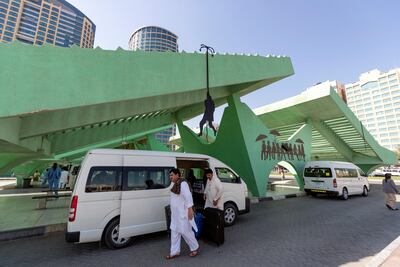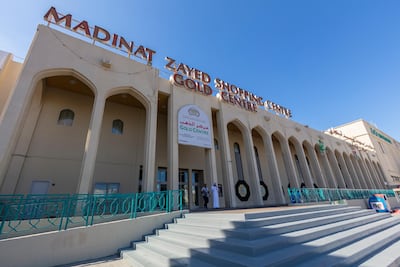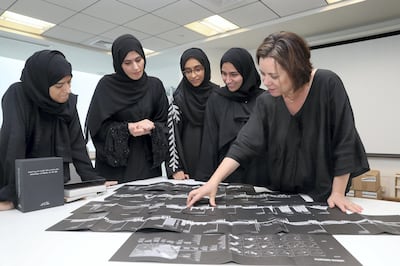At first glance, Adnan Butt did not think his new home held historic significance. Pigeons flew overhead, satellite dishes and drying clothes cluttered balconies. “The building is old and a little crowded,” says Butt. “Only two lifts working.”
But Al Ibrahimi Building, a 16-storey cylinder of interlocking concrete squares, is considered an Abu Dhabi classic.
After it opened circa 1983 on Electra Street, the ground-floor restaurant became a place for weddings and graduation parties, its flats homed hundreds, and its woven, basket-like design helped spark debate about the preservation of modern heritage architecture.
The time in between 'pre-oil' and 'today'
Last week, Abu Dhabi's Department of Culture and Tourism announced a new campaign to raise awareness of architectural gems such as Al Ibrahimi Building. Other sites include Abu Dhabi Central Bus Station, Madinat Zayed Shopping Centre and the Cultural Foundation.
This is part of a conservation plan by Abu Dhabi’s Modern Heritage Initiative, which started in 2011 by identifying sites for preservation. Often, these are buildings in lower-income areas. Details on the campaign are yet to be announced.
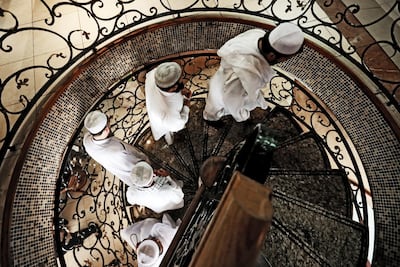
The stories of these buildings and their tenants tell of the transition from pearling village to glass metropolis.
“We have a lot of then-and-now-style books, which show the UAE’s history as ‘pre-oil’ and ‘today’ but this implies nothing happened in between,” says Matthew Maclean, a historian specialised in late 20th-century UAE history.
“What we see in daily life in Abu Dhabi didn’t spring up from nowhere. These buildings represent a stage between those times, the country’s early modernisation, which was a period of 20, 30 years.
“They represent the UAE in which many Emiratis and expats grew up, so for a lot of people, modern heritage has nostalgic value. For people newer to Abu Dhabi, their preservation tells us that this is a place with history, even in a very young city.”
The influences on architecture in the capital were wide-ranging
Each arrival brought their own interpretation of modernity.
Japanese planner Katsuhiko Takahashi and Egyptian architect Abdulrahman Makhlouf laid out Abu Dhabi's superblocks and green spaces. A state-owned Bulgarian architecture firm brought Soviet brutalism: gargantuan concrete structures like the municipality building and the central bus station.
Canada's celebrity architect Arthur Erickson gave the city its sea-glass Etisalat building topped with a giant golf-ball and Rifat Chadirji, the father of modern Iraqi architecture, designed the National Theatre.
All of this was overseen by Sheikh Zayed, the Founding Father, who worked closely alongside planners and would draw city plans in the sand with his camel stick.
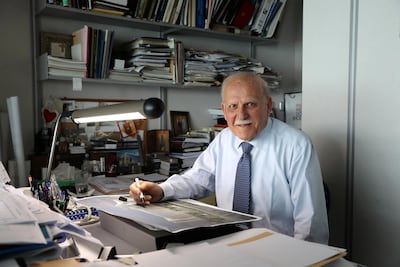
From Morocco to Moghul India: ‘you felt the Islamic touch’
For architects, it was a dizzying time. Maher Megallaa landed from Egypt in the midst of the boom and designed about 30 buildings in Abu Dhabi. His skyscrapers added to the city's distinctive concrete facades.
“I came here by the fourth quarter of ’76 and, really, when I came, the maximum height was about 11 floors and that was on Khalifa Street, which was downtown,” says Megallaa.
In 1984, Sheikh Zayed issued a decree to the municipality and public works department to ensure that public and private buildings would “reflect the Arab, Islamic character and the history of the civilisation of the region”.
It didn’t matter where the Islamic motifs originated, so inspiration came from far and wide, from Morocco to Moghul India, recalls Megallaa. “You felt the Islamic touch and that’s what Sheikh Zayed was looking for.”
Demolition meant older buildings were lost
Then came the people who filled these buildings – this included Iranian framers, barbers from Bangladesh, printers from Lahore, Keralite accountants, Egyptian doormen, English teachers, Ugandan cabbies and Filipino bakers.
Decades passed, buildings aged, rents dropped and rooms grew crowded. Abu Dhabi expanded to mainland suburbs and outer islands including Reem and Saadiyat.
The value of older, downtown buildings fell into question.
The souq burned down in 2003, the volcano fountain of the Corniche was razed in 2004, the monumental cement canon of Al Ittihad Square was demolished without ceremony around 2014.
The neon lights of El Dorado, a South-Indian cinema named after a Beirut movie house, went dark in 2017 after 46 years. One year later, another Electra Street institution, the Butt Sweet House, closed its doors for good.
Demolition is constant. In August 2018 alone, the municipality announced it had demolished 220 buildings and earmarked another 272 for removal.
Stories of the people who passed through
"When those buildings come down, they're losing the layers of history," says Michele Bambling, who was creative director of Lest We Forget: Structures of Memory, an archive of UAE's recent urban development.
The structures not only tell the story of Abu Dhabi’s rise as capital, but its intimate history. “Those buildings contained things we could never see,” says Bambling. “It’s hard to see the lives of women and children in the public realm and in the public record. If we can capture the memories of the people who occupied those places, we can also capture the family stories and the stories of the people who are from here and the people who passed through here.
“The shared national stories, the entering on the international scene and the individual stories of the families, all of that is encapsulated and contained within these structures,” he adds.
‘The nation was young and recently unified’
For the generation raised among these places, the buildings hold inspiration. Graphic designer Hussain Al Moosawi has spent years photographing their facades. “As much as it’s about the buildings, it’s also about the areas where those buildings exist. For example, many fall on Electra and Hamdan streets, which, for many, used to be quite central to their life in Abu Dhabi but [are] no longer for those who moved out to greater Abu Dhabi or those who started occupying newer parts of the city.”
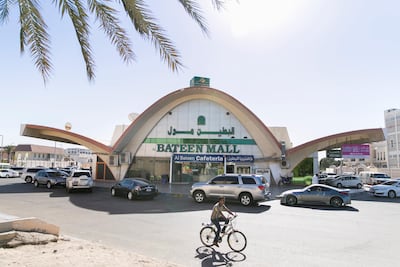
He considers his work as documentary, aware of the buildings’ impermanence. “They show an example that blends contemporary ideals with the heritage of the region, something most buildings built these days fail to accomplish. For artists and photographers, these buildings offer a fertile subject for those who want to study the UAE’s early urban identity, when the nation was young and recently unified,” says Al Moosawi.
Megallaa’s heart lightened when he read of the Modern Heritage Initiative.
He has spent a month in isolation with his wife, in their Abu Dhabi apartment amid the coronavirus pandemic. This was the first time in half a century that he wasn’t regularly at the office, creating new designs for the emirate.
Over the decades, Megallaa has watched his buildings demolished and replaced with taller skyscrapers. “Really, I prefer if they take care of the old buildings ... not have them demolished. There are some buildings in Egypt that are more than 50, 60 years and they’re still there. But nowadays, everybody is going to go higher.”
‘A very good surprise’
Butt moved from Al Ibrahimi Building after a few months, but still works as general manager at Al Ibrahimi Restaurant. Guests tell him of childhood visits and wedding parties in its garlanded, thickly curtained banquet hall.
Even amid the pandemic, the building is his anchor to community. He currently oversees its annual Ramadan food drive, a lifeline for those recently unemployed because of the crisis. Butt’s work in the building honours the city’s heritage. “Actually, old buildings have bigger characters. And bigger balconies. It’s a very good surprise that they’re recognising it.”
If the campaign succeeds, people won’t be surprised by the recognition at all.









